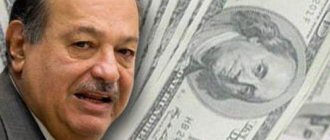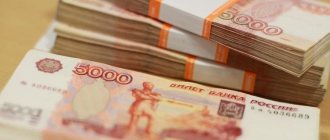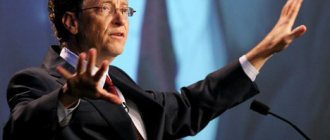The Oracle, the sage of Omaha, the richest investor - as they called him. Some believed that he was simply lucky, some were surprised at his incredible intuition, while others assumed that he had sold his soul to the devil. We are talking about one of the richest people in the world, Warren Edward Buffett, who is considered the most famous and great investor of our time. He formulated effective rules for doing business that are used by entrepreneurs from around the world. He is the author of an unprecedented initiative - a call for billionaires to give half of their wealth to charity. It was put forward in 2010, and by 2020 the agreement had been signed by more than 150 people.
In 2020, Warren Buffett was ranked as the third richest person by The Bloomberg Billionaires Index. Only Bill Gates and Amancio Ortega managed to bypass it. Then his fortune was estimated at 65 billion dollars, and in 2020 - at 77.3 billion dollars. An analyst, intellectual, entrepreneur, professional in long-term investing, he is a legend, ideal, and idol for businessmen, brokers, and investors.
In the 2020 election, Buffett supported and sponsored Democratic candidate Hillary Clinton.
Quick navigation:
Childhood and youth of an investor
Warren Buffett was born into an ordinary family on August 30, 1930 in Omaha, Nebraska. His father made money as a stock trader, then became a congressman, his mother was once a fashion model, but after the birth of her first child she had to abandon her career and focus on creating home comfort. Buffett had two sisters, Roberta and Doris.
From early childhood, Warren began to be interested in finance. This was largely due to my father’s profession. He completed his first project at the age of 6, impressing his family with his resourcefulness and intelligence. With the money he collected, he bought a couple of cans of cola, which he sold to his parents for twice the price. And at the age of 11, he and his sister invested money in the Cities Service company, which supplies gas to residential buildings. First, the stock price dropped, which made the future investor a little worried, and then rose from $38 to $40. In a hurry, Buffett sold the shares. He will have to regret this decision, since soon their price will increase 5 times.
But it was a useful experience that taught the businessman to be balanced and thoughtful. Since then, he has preferred long-term investments. One of his famous phrases: “If an investment is designed for less than 10 years, it is meaningless.”
In 1942, Warren Buffett's father entered Congress and the family moved to Washington. Warren continues to study at school and works part-time on new business experiments. Warren Buffett's biography also includes work as a courier: at the age of 13, he became a courier for the Washington Post newspaper. In a year he managed to save 1.5 thousand dollars. For this amount, the investor purchased a plot of land, which he managed to rent out to farmers and make money from it. Buffett was also interested in the gambling business. No, he didn’t play the slot machines or place bets. He bought broken, damaged pinball machines for a ridiculous price, restored them, and installed them in the most visited places. Buffett shared his profits with the owners of the institutions, and he himself earned about $600 a month.
Video: Become Warren Buffett
First steps in business
His father was the owner of a brokerage company and a congressman. However, since childhood, Warren tried to earn his own money and do his own thing. His first deal was speculative: the boy bought several cans of Coca-Cola in his grandfather’s store and sold them to his family for twice the price. Thus began Warren Buffett's journey into business. At the age of 11, he first tried to play on the courses, first buying and then selling three shares. Then he rushed to sell the shares due to minimal profits. However, their price soon increased sixfold. There was no need to rush. This served as a lesson for Warren.
From the age of thirteen, he worked in the post office, delivering the Washington Post. The work was piecework and, having developed his own system, he began to earn more than the postmaster. At the age of 15-17, together with a friend, they bought and installed three used slot machines in the city. By the age of 17, he had funds in the amount of 5 thousand dollars, which, when calculated taking into account the inflation index, amounted to more than 40 thousand dollars. Warren was determined to make money and become a millionaire by age 30. But his father convinced him of the need to get an education. The University of the District of Columbia brought him into contact with a prominent theorist of the financial market and investments, Graham, who managed to interest the young man in his harmonious theory. The Tao of Warren Buffett has been found! Now he knew exactly what he would do in life - invest.
Student years
Buffett studied at the financial school of the University of Pennsylvania, where he entered in 1947 at the insistence of his parents. Warren himself did not want to study, as he considered it a stupid waste of time. For him, his business projects were more interesting. But my father thought differently; he insisted that there is no future without education. By the way, the young man knew much more about business than his theoretic mentors, so he quickly got tired of dry lessons. Just a year was enough for the young entrepreneur. Afterwards, he drops out of the university, returns to Nebraska and continues to be involved in the newspaper business, only no longer as a courier, but as the head of the delivery department, and then as a co-owner of the office.
Warren Buffett sets himself more and more new goals, and achieves them. So, now his interests have turned towards the stock market. During this time, he had family capital at his disposal and had some savings of his own. He starts investing. At the same time, he manages to graduate from the University of Nebraska. Now Buffett understands why he needs education and continues to study. In 1950, an attempt to enter Harvard University ends in failure. Refused due to being too young. Warren enters the capital's Columbia University, where he has a fateful meeting with Benjamin Graham, who at that time was a shark in the investment business.
Education
Buffett spent two unsatisfactory years at the Wharton School of Business and Finance at the University of Pennsylvania and then transferred to the University of Nebraska. He took fourteen courses in one year and graduated in 1950. He was not yet 20 years old.
Returning to Omaha, Buffett reconnected with the stock market. One day at the local library, he came across Benjamin Graham's recently published book, The Smart Investor. “It,” he said, “was like seeing light.” Buffett soon left Omaha to study with Graham at Columbia University's Graduate School of Business.
There were twenty students in Graham's class. Many were older than Buffett, and some worked on Wall Street. That evening, these Wall Street professionals sat in Graham's class discussing which stocks were grossly undervalued and how they would go back to work the next day by buying the stocks they had analyzed the day before and make money. It soon became clear to everyone that Buffett was the brightest student. He often raised his hand to answer Graham's question before Graham had finished asking it. Buffett's grade for the class was an A+, the first such grade Graham had awarded in twenty-two years of teaching.
Worrell Buffett and Benjamin Graham
Graham had a very big influence on Warren Buffett's worldview. If for most subjects of the investment market investments were something like playing roulette, then Mr. Graham considered it a whole science with its own rules. In his lectures, he taught his students that it was necessary to conduct a thorough analysis of companies. The teacher believed that it was necessary to buy the assets of those companies that were barely able to stay afloat. Why is this beneficial? First, the shares are inexpensive. Secondly, at any moment the company can be revived and then the value of the securities will increase significantly.
After taking Benjamin Graham's financial literacy course, Buffett concluded that he needed to do the opposite, and it was the right decision. He planned to invest the money in businesses, not stocks. Graham highly appreciated Buffett's potential and abilities, but their personalities did not match.
See also: Participation in tenders, government procurement and electronic trading for beginners
Warren's character was not the gentlest: after finishing classes, he could spend hours challenging his mentor's theories, refute them, put forward some of his own assumptions, and openly argue and interrupt during lectures.
Buffett graduated from the university, but did not want to part with his teacher; he was ready to work for the mentor for free. However, Graham rejected this offer, accepting it only after a while. Buffett worked for Graham's company for six years. During this time he managed to obtain a considerable fortune. He returned home and in 1957 founded the investment company Buffett Associates. Participants paid a membership fee of $25 thousand. The initial capital amounted to 105 thousand rubles, and in just six months the amount tripled.
The path to billions
Despite the fact that Berkshire remained his main business, over time Buffett began to diversify his investments into several areas that he considered very promising. In fact, the main company itself began searching for attractive investment opportunities, becoming an investment fund in the modern sense. One of these areas was the insurance business, which very quickly took a significant share of Warren’s overall financial flow. Currently, some of the best-known brands are owned by the Berkshires, such as Geico. The investor himself has repeatedly said, again, a very simple truth - “insurance money costs us cheap.” And this has a very deep meaning, because an investment is always a risk, even if it is made by Warren Buffett (there is an example of a failed investment in IBM).
Buffett used his insurance company fund to invest in company stocks. The logic is simple - a well-established insurance business operates at least without losses, while providing a colossal amount of funds for temporary use. As a result, it turned out that investments from this kind of money amounted to more than 100 billion dollars. Now let’s imagine that this is loan money from a bank or from investors who want a comparable interest rate. And that’s all, there wouldn’t be a billionaire now, but just a successful, gifted, savvy person. But he came up with a scheme and was able to make a huge fortune from his relatively conservative investments, which, by the way, he, along with some other rich people, bequeathed to charity.
Warren Buffett's success story
Warren Buffett's investing is deliberate and measured. There are no spontaneous decisions or unjustified actions in his activities. The financial guru preferred to invest money in those companies that are afloat and have good, well-established management. He carefully analyzed all available information about the company he wanted to buy. Buffett studied not only the financial statements of enterprises, but also the biography of people occupying TOP positions and the corporate structure of the company. He was not interested in short-term speculation. “The best time to sell a stock is never” is Buffett’s favorite quote.
Buffett's strategy brings excellent results, constantly increasing the investor's wealth. In 1969, the value of the shares of his investment organization reached $102 million. Things were going great, but then, unexpectedly for everyone, Buffett sold it and used the proceeds to buy out the textile company The Berkshire Hathaway (BH), which was not doing very well. Assets were sold for $8, and their real value reached 20. Buffett had some kind of instinct, because in three years he bought half of the company’s shares, and all the proceeds from the transaction were used not for circulation, but for the purchase of remaining securities. At that time, insurance companies began to develop, for which the state allocated considerable tax benefits. 5 large insurance companies are becoming the property of Warren Buffett, and this is another step on his path to becoming a billionaire.
Buffett never relied on chance when choosing investments. Only fundamental analysis and keen instincts helped him make the right decisions. He did not need shares, but a successful, functioning and profitable business. The investor pays special attention to those shares that are undervalued by competitors. The amount of money invested in the development of companies increased exponentially. There are many examples: Coca-Cola, Gillette, The Washington Post. Warren Buffett never resorted to speculation, his investments were "solid and reliable."
The financial market is Warren Buffett's calling
After completing his studies, Warren began working as a manager in his father's company.
At age 22, he married Susan Thompson. Two years later, he organized a company with the shares of friends and acquaintances. He then had experience working in the company of his teacher Ben Graham - the Graham-Newman investment fund, located on Wall Street. At this stage, he already has a fortune of 140 thousand US dollars. Despite the opening prospects, Warren makes the decision to build his own business. He returns to Omaha and, having managed to attract funds from friends and relatives, establishes his own company. Since the early 60s, shares of this company have grown by 251% in the first 5 years, while on average the American stock market “rises” by 74% during this time. Over the next 5 years, this gap widens even more: 156% for companies invested by Warren and 122% for the rest of the market. A childhood dream comes true - he becomes a millionaire. Warren Buffett has established himself as a keen specialist in mergers and acquisitions. He has large investments in the American insurance business. The second stage of his activity began in 1969, when he invested all the proceeds from the Buffett Associates fund (and this is $102 million) into the bankrupt textile company Berkshire Hathaway, thereby giving it an impetus for development. An experienced analyst noticed, based on the assessment of assets, that the real price of one share was 20 dollars, while it was sold for 8. But the textile business turned out to be not the end point, but an intermediate base for the next investment. Profits from the sale of products were used to purchase securities of insurance companies. America at that time was forming its own insurance market, and significant government benefits were the key to high profitability of the insurance business. Warren Buffett chose a wise and far-reaching strategy. His biography as an investor on a national scale began precisely from this stage, when the five largest US insurance companies became his property.
Subsequently, an investment mechanism was launched based on the redistribution of insurance premiums from clients to these companies. For part of the funds received “in advance”, bankrupt “solid” companies were bought up. Having received financial support, they almost immediately became profitable. Thus, thanks to the profits of skillfully invested enterprises, Warren Buffett received another source of financing. His biography testifies: having exchanged his fifth decade, he became the owner of a 28 billion dollar fortune.
“If you are all so smart, then why am I so rich?”
Many books and articles are devoted to the success story of Warren Buffett. As a person, he is an idol for many. His name is shrouded in secrets and legends. But don’t think that everything in life was easy for him. There were ups and downs in his biography. Buffett was criticized, envied, and admired. He is original and eccentric, and knows how to surprise. In an artistic style, he wrote messages to investors, partners, shareholders, and compiled annual reports. For his "clarity, insight and wit" he received a National Commission Award in 2005.
Buffett's eccentricity is off the charts. He is not afraid to joke publicly, he always has ready answers to any questions. His phrases are quoted by journalists. The experience, investment principles, strategies of this person are a model for inheritance. When representatives of the financial community tried to criticize one of his many unexpected and unpredictable transactions, Buffett responded with a sarcastic phrase: “If you are all so smart, then why am I so rich?”
Today, with one word, Buffett can bring down the shares of any, even the most successful company, or, conversely, increase the value of assets significantly. This happened with Omnicom. After the purchase of its shares by Buffel, the quotes rapidly went up.
The investment strategies of the financial guru are worked out to the smallest detail. To invest in a company, he must know everything about it and its product. He invests in those enterprises whose products he himself uses. This can be seen in the example of such large packages: American Express, The Washington Post, Coca-Cola, Walt Disney, McDonald's.
Surprisingly, but true, Buffett’s portfolio does not include companies that engage in high-tech developments. Why? Because the investor simply does not use their goods and services. According to him, he doesn’t even have a computer. He calculates super-complex mathematical combinations in his head and manipulates multi-digit numbers easily and without outside help.
Entrepreneurial activity
In 1956, Buffett opened his first investment partnership. It's starting to operate in Omaha. In five years, he manages to increase the value of each share by 250%.
Warren Buffett's investor tactic was to analyze companies closely, never limiting himself to annual earnings reports. He was interested in everything, right down to the biography of top managers, prospects for the development of this area, and the history of the company.
His foresight and adherence to a pre-chosen profession led to the fact that in 1965 he dissolved the partnership in order to acquire a textile company, which at that moment was on the verge of ruin. He changes the direction of its activities, refocusing on investments and insurance transactions. The company is doing well, and it still remains the billionaire’s main asset.
Another rule of Warren Buffett: invest money in clear and simple areas of business. For example, he often purchased shares of those companies whose products he constantly used. For example, this is the Washington Post, Coca-Cola, McDonald's, Gillette.
Warren Buffett - Oracle of Omaha
One of Buffett's most famous nicknames is the Oracle, Sage, or Seer of Omaha. Their appearance is associated with the extraordinary predictive abilities of the investor. Just a few years ago, when investing in high-tech developments was at the peak of popularity, competitors wondered why Warren Buffett refused to work in such a promising direction. They rubbed their hands contentedly and counted future profits. But something happened that no one expected. The NASDAQ index, which is the main criterion for the development of the high-tech market, began to decline rapidly. Investor losses were colossal. Buffett's companies only got stronger. But this is far from the only investor forecast:
- In 2020, Buffett said that cryptocurrency was unstable and would sooner or later begin to rapidly fall in price. And so it happened. At the beginning of 2020, the cost of Bitcoin reached 20 thousand dollars, a month later - 14 thousand dollars, now about 7 thousand dollars.
- In 1985, after conducting a thorough analysis of Berkshire Hathaway, an investor predicted that the company's capital would increase by 48.2% in 75 years. The only mistake Buffett made was timing. The stock rose 48.3% already in 1998. Today Berkshire Hathaway's capital is $323 billion.
- In 2005, Warren Buffett argued that the then successful Sears company would disappear from the market due to being crowded out by stronger competitors. And so it happened. Soon the head of the corporation sold the shares.
- In 1998, the investor traditionally wrote a message to shareholders. In this he pointed out that Coca-Cola and Gillette would be the best in their industry. He was right.
- After the global crisis, a housing problem arose in the United States. Buffett was confident that there would soon be a huge volume of residential construction, and he was right. In just a few years, the United States managed to restore the housing market and provide jobs to the population.
- In 2004, an investor predicted the dollar would fall. He advised Americans to quickly get rid of this currency and buy the euro. Once again, Buffett was right.
See also: Current and promising professions for the next 10 years. What awaits us after 2020?
These are not all the predictions of the richest investor, which were destined to come true. It's not just intuition that helps Buffett come up with the right thoughts and make the right decisions. This is also due to deep critical thinking, because a financier has the habit of very scrupulously studying issues, analyzing, comparing, and drawing conclusions.
Personal life
In 1952, Buffett married Susan Thompson. In their marriage they had three children - Howard, Susan and Peter. The wife always supported her husband in all his endeavors, and also influenced his political views and attitude towards charity, making him one of the largest donors in the world.
However, after the children grew up, she left her husband, lived separately from him, without filing for divorce. At the same time, the woman remained a close and faithful friend to him, often helping even in personal matters. For example, it was Susan who introduced Buffett to Astrid Menks, with whom the billionaire had an affair for some time. Menks is a native of Latvia who has spent her entire life in America.
Susan herself maintained an excellent relationship with Warren himself and his new lover until recent years. In 2004, she died of cancer. Soon after this, Buffett legalized his relationship with Astrid; before that, they lived in a civil marriage for about 20 years.
As it soon became clear, the billionaire himself was susceptible to cancer. In 2012, he underwent treatment for prostate cancer, which was successful.
Management Strategies
Warren Buffett never interferes in the management of the companies in which he invests. The only thing he can do is appoint or remove the general director, as well as determine the amount of his salary. If the company achieves results over a certain period, the manager receives management stock options as compensation. The directors of Buffett's companies are personally interested in increasing profitability, because their benefits depend on it.
Buffett is trying in every possible way to minimize risks and financial losses. He would rather refuse an interesting offer than lose money on it. The investor believes that the economic system in the world is functioning extremely incorrectly. There are a lot of intermediaries (traders, brokers) who profit from transactions, and for the recipient and sender the cost of monetary transactions increases. Warren Buffett suggests limiting the number of transactions allowed per person.
Buffett developed his own corporate governance strategy, which is embodied in 13 principles. They were formulated back in 1983, but until now there has been no doubt about their effectiveness. The success of his companies is due in part to the fact that he involves shareholders and managers in management and investment. All entities are partners who are personally interested in ensuring that capitalization increases and risks are minimized. Part of the shares is distributed between the chief directors of enterprises and members of their families. Buffett explains it simply: if a company loses money, directors' earnings decrease. The latter, naturally, are not interested in this, so they will do everything to increase profitability.
Meeting with the first Teacher
In 1950, Warren Edward Buffett tried to enroll at Harvard, but the university's admissions committee rejected his candidacy because he was "too young." Benjamin Graham , lectured .
He became a famous stock player already in the 1920s, buying up undervalued shares that no one else was interested in, but suddenly, some time after Graham bought them, began to rise sharply in price. While all stock market players viewed the stock market as a game of roulette, Graham considered it a science and diligently studied the balance sheets of the companies in which he planned to invest.
still uses the ideas and principles of his first Teacher , “mixing” them with the approaches of his other teachers. In its pure form, Graham's principle had one drawback - it did not pay attention to either the quality of the management of the acquired company or the specifics of its industry.
Buffett primarily analyzes these indicators. The more time passes, the less he "remains Benjamin Graham." These are the realities of the modern stock market.
Implementation of investment ideas
You can see how Warren Buffett puts his investment ideas into practice using a fairly simple and entertaining example. For a long period, investors preferred Pepsi products. One day a can of cherry cola fell into his hands. The taste, familiar from his childhood, plunged him into memories when, as a child, he handed over soda cans and received money for it. Then he came up with a very successful idea: for most people, soda is Coca-Cola. The businessman was interested in both the product and the company, and he decided to study them in detail. Buffett delved into the history of the creation and development of the company, studied the composition and properties of the drink, and analyzed everything down to the smallest detail.
Buffett argues that a common mistake most analysts make is that they only perform superficial analysis without going deeper. And in the depths, as a rule, quite interesting facts are hidden that can influence the final decision.
As it turned out, the much-advertised and beloved Coca-Cola by all Americans is just syrup and soda. The drink is placed in a tin can, the design of which was constantly changing, adapting to the tastes of the target audience. Buffett considered the profitability of the business to be very good. From every dollar the company received up to 80 cents of net profit, and only 20 cents was the cost of the drink. The investor became convinced that Americans would buy and drink cola regardless of any factors (natural disasters, financial instability, etc.). He invested a huge amount of capital in the Coca-Cola company, and it was one of the most successful transactions in his life.
"A dollar saved is a dollar earned"
Have you seen Walt Disney's DuckTales? There is also the main character Scrooge McDuck, who constantly repeated the phrase: “A dollar saved is a dollar earned.” So, the authorship of this phrase is attributed to none other than Warren Buffett. The investor cannot be blamed for wasting money. He is very thrifty, if not stingy. He lives in an ordinary house in Omaha on Farnham Street, purchased back in 1957 for $31.5 thousand. An old Honda, bought for $700. on the secondary market, he drives it himself.
If you saw Buffett in real life, you definitely wouldn't think he was a millionaire. The appearance is simple and neat; the businessman clearly does not go to stylists. Middle class boots, not branded, bought in a regular store. It even says “thrifty” instead of license plates.
The only thing that connects an investor with luxury is the game of aristocrats - golf and a passion for expensive sports helicopters
Buffett is also not used to pampering children. One day his son Howard approached his father with the idea of buying a farm. Warren helped, but his help was unique. The businessman bought the farm and leased it to his son. The latter had to pay interest to his father. And when Buffett’s daughter Susie asked him to pick up her car from the airport garage, he asked him to write a receipt saying she was borrowing $20 from him.
Buffett cannot be called greedy. In 2010, he initiated the Giving Pledge program, which involved dedicating more than half of his wealth to charity. The businessman donated $37 billion.
Features of Warren Buffett's investing
Many people wonder how to follow Buffett’s example, how to learn how to invest money wisely, because, judging by advertising, “it’s easy to earn millions, you just need...” But in reality, everything is very, very complicated. It is possible to achieve such mastery; the investor himself has spoken about this many times. It just requires a careful study of all aspects of not only economic activity, but also an understanding of market psychology.
One of the most interesting works on this topic is a fairly famous book written by Robert Hagstrom, called “How to turn 5 dollars into 50 billion . She talks about a genius from Omaha, describes his train of thought and gives food for thought. You can download it from the link below.
So now let's look at the aspects of the investing approach that allowed Warren Buffett to reach the pinnacle of finance:
- In-depth analysis of company indicators. This is such an important point that his wife often complained about excessive attention to finances and family. Only a comprehensive assessment can be effective. To identify whether a company is undervalued, you need to find its strengths, which will allow it to grow in the future. Buffett also paid great attention to the industry as a whole, for example, after some time after working in the delivery of newspapers, he made a very solid investment in newspaper stocks, which brought considerable profit. Now he keeps up with the times and also invests in social projects. But in the minds of an ordinary person who sees newspapers, it is difficult to see the prospects for the development of other information media.
Warren Buffett in his office - Asset diversification. Sometimes it can feel like Warren Buffett focuses on one industry. For example, there are known facts of purchasing significant blocks of shares in Bank of America, Wells Fargo and Goldman Sachs. These are all representatives of the banking sector. Considering that the amounts involve tens of billions, one might indeed conclude that he prefers financial institutions. But this is not true at all. The volume of purchases is simply very large. And if you look, you can see that Warren Buffett’s portfolio consists of a variety of companies, it just so happens that during crises, it is the banking structure that suffers first, which means that it needs to be taken from the bottom, as Warren Buffett’s investment rules indicate.
- Scale . Buffett invests in a wide variety of companies, not only in terms of their focus, but also in terms of their size. For example, Charter Communications. This is a telecommunications company that, not so long ago, was very small. Buffett invested a decent amount of money and what we see now is that CC is firmly in second place among cable broadcasters in the United States. And this is no coincidence, there are a lot of examples, it’s just that this one best shows how deeply Warren dives into analyzing activities and assessing prospects. Bringing a very young enterprise to such a level is a difficult task, but seeing, evaluating and taking advantage of the opportunity is almost impossible. After all, there are hundreds, thousands of similar companies on the market.
Warren Buffett's personal life
In 1949, Warren Buffett really liked a girl whose boyfriend played the ukulele. The future successful businessman, who was used to achieving his goals, also bought a small guitar and learned to play it. Although he failed to win the girl’s heart then, the ukulele will now accompany him through life.
See also: How to write an explanatory note for work, university, school, kindergarten - samples and examples
The richest investor got married at 22. His chosen one was Susan Thompson. From this marriage three children were born: Peter, Howard and Susie. The couple lived together for 25 years, after which they silently separated. The matter did not come to an official divorce. In 2004, Susan died of cancer. 2 years after her death, the businessman met his longtime friend and current wife Astrid Menks. She was 60 and he was 74 when they got married. Warren's biography has not only white streaks, there were also difficult times, for example, a terrible illness. The great investor, like his first wife, also suffered from cancer in 2012. But he managed to overcome the disease and return to a full life.
The head of a financial empire is quite conservative in everyday life. One of his favorite pastimes is playing bridge. Buffett is a Nebraska football fan. In addition to the house in Omaha, he also has real estate in the state of California - a villa in Laguna Beach, which is valued at $4 million. In 1989, the businessman spent $6.7 million. to purchase your own helicopter. Warren called this decision an unjustified waste of money.
The investor’s adopted granddaughter Nicole starred in the film “The One Percent,” the main problem of which is the financial stratification of society. After this, Buffett disowned his granddaughter and deprived her of all help.
Warren's wife and children
It's time to talk about the personal life of the legendary investor. At the age of 22, he married Susan Thompson, a girl from his native Omaha. She bore him three children: Susie, Howard and Peter and lived with him for 25 years. But Warren was always absorbed in his business, not paying enough attention to his wife and children. Of course, he loved them very much; warm family relationships were instilled in him by his parents. But his main passion always remained work.
Susan was sociable, loved parties, and sang in cabaret. That is why she left him for an idle life in San Francisco. But they did not divorce and even appeared in public together from time to time. So, they lived in different cities until Susan died of cancer in 2004. In honor of the memory of his first wife, Buffett founded the Susan Thompson Buffett Foundation and still makes periodic contributions to it. 2 years after the death of his wife, he remarried his longtime girlfriend Astrid Menks, 16 years his junior. It is curious that they were introduced by his first wife.
The Buffetts raised their children to be self-sufficient, simple people. They studied at a city school, communicated with peers from their street. The businessman didn’t even have an office for a long time. To understand how much the Buffett family was and remains an ordinary ordinary family, it is worth knowing about an interesting fact: the offspring learned that their father was a billionaire only when he was included in the Forbes list. They and those around them were surprised, to put it mildly. And this did not change them at all, nor their behavior or lifestyle.
Warren Buffett's Golden Rules
Warren Buffett is consistent in his actions and decisions. He does not rely on intuition, although this is often attributed to him. The success of investor projects is a huge effort and constant work. To achieve it, I had to thoroughly study the peculiarities of the functioning of the financial market. Every time a businessman plans to invest money, he carefully analyzes the feasibility of the investment and its return on investment. Buffett also has life principles that have been tested by time and experience, which he consistently adheres to throughout his life. So, here are Warren Buffett’s “golden rules”:
- You can't afford to lose money. You shouldn't invest in just anything. Investments love calculation and analysis. The businessman recommends investing only in companies with a good reputation.
- Don't adapt to other people's opinions. It is unlikely that those around you wish you well and success. So why pay attention to their criticism then? You have a goal, you have a path, nothing else matters.
- It is important to understand the project you are going to invest in. Buffett did not invest in technical developments and new products about which he understood nothing. He ate at McDonald's, read The Washington Post, drank Coca-Cola, watched Walt Disney, and invested money in these companies.
- The market is not always right. The investor recommends using theoretical knowledge and practical experience of successful individuals to determine the real value of assets. He considers undervalued stocks to be especially valuable.
- The investment period is not limited. If you are buying shares to resell them later, don't do it. In this case, you simply do not need these assets. Investments must work. By the way, Buffett himself does not sell shares, he only buys them.
- You can't be afraid of rejection. Even if they convince you that the project will be successful, but you are tormented by doubts, refuse.
Of course, Buffett is no visionary. He cannot and does not try to predict everything. He is just a person who also makes mistakes and suffers losses, including financial ones. But this is an example of how to make billions from nothing. A businessman knows how to admit his mistakes and let them go, drawing conclusions. He is not afraid of mistakes, because only those who do nothing make no mistakes.
Charity
Buffett is known for his generosity in participating in various charitable causes. For example, in 2010, he donated more than half of his capital to the Gates Foundation. In the same year, together with a computer genius, he organized. Everyone who wishes to join it is obliged to donate at least half of their wealth to charity. This act created a real sensation because it became the largest donation made in the entire history of mankind.
At the moment, more than a hundred billionaires have already joined the project. Among them are George Lucas, Michael Bloomberg, Mark Zuckerberg, David Rockefeller.
He has a Buffett rule: once a year, have breakfast with the person who wins this right at an auction. The record was set in 2012, when $3.5 million was collected. All money is sent to charity.
Books in the life of Warren Buffett
The example of Warren Buffett is another proof that knowledge helps achieve success. At the beginning of his career, the businessman read a lot, up to 1000 pages a day. An investor today spends 80% of his free time reading a book. As he himself states, his job is to collect a large amount of facts and information. Here is a list of books that Buffett recommended reading:
- “The Smart Investor” (B. Graham) - a guide to value investing, read by a businessman at the age of 19, it was this book that gave an understanding of how investments work and how to make them correctly;
- “Security Analysis” (B. Graham, D.L. Dodd) - this book helped Warren draw up an investment map, learn how to carefully analyze securities in order to determine the real value (F. Fisher) - for an objective assessment of the company and its assets, it is necessary to take into account not only financial indicators, but also the management system;
- “Stress Test: Memoirs of the Financial Crisis” (T. Geithner) - every manager should read this book, it talks about how to manage a company in times of economic disaster.
Warren Buffett's ideas are also published in books. Among the most popular are “How to turn 5 dollars into 50 billion”, “W. Buffett’s rules of investing”, “Think like Benjamin Graham, invest like Warren Buffett”, etc.
Why is Warren Buffett loved in the United States?
An important fact that characterizes him as a person is his voluntary renunciation of 50% of his property (which is about 37 billion dollars). With one stroke of the pen, he did not hesitate to transfer these funds to American charitable foundations. This is how he responded to Bill Gates' call in 2010 for wealthy Americans to give half of their wealth to the country that made them rich. It was the world's largest and truly impressive act of charity, an example for all wealthy people. The funds were transferred mainly to a fund managed by the Gates spouses: Bill and Mellinda. Without exaggeration, the whole country was deeply surprised by this act of a man previously famous for his frugality. It was a truly patriotic act, a living response from Buffett’s soul to the terrorist attack on the American Twin Towers.
He is really loved in his native Omaha; he, a billionaire with a worldwide reputation, does not hide from people, he freely visits stores and other public places.
Once, when one of the Omaha schools faced significant financial sanctions and the threat of closure, an elderly couple of teachers from the same school came to the rescue. They transferred several million dollars to the required account. Where did they get them from? The teachers turned out to be one of the first shareholders of Buffett's company, entrusting him with all their savings - 25 thousand dollars.
To the correspondent’s question about how he understands what success in life is, he replied that the most important thing is loving people around, and how much you have in your safe deposit box is secondary. Warren Buffett really does have these beliefs. News and current events have little impact on his life values. Indeed, this intelligent, but willful and charismatic man is loved by his family and others.











